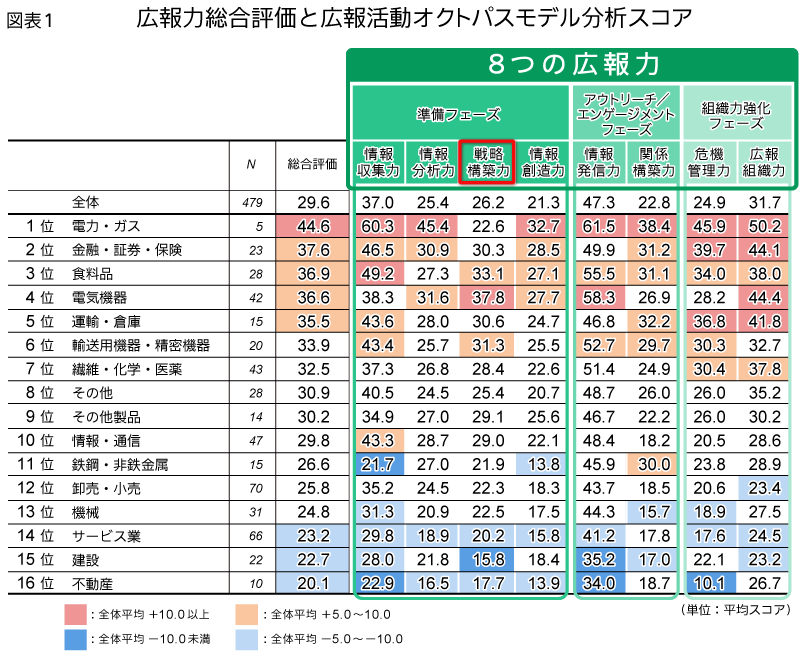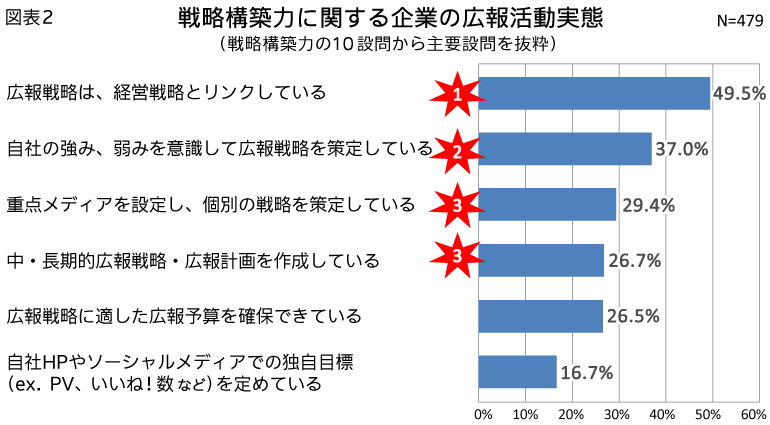This is the seventh installment of our series on the " First Survey on Corporate Public Relations Activities," conducted by the Corporate Public Relations Strategy Research Institute targeting 479 listed Japanese companies. This time, we explain the third element of the "Public Relations Octopus Model Analysis" – "Strategy Building Capability" – which breaks down corporate PR activities into "Eight PR Capabilities."

"Strategy Development Capability" is one of the four categories within the "preparation phase" of the "Eight PR Capabilities" (information gathering, information analysis, strategy development, information creation). Our institute defines "Strategy Development Capability" as: ① "Developing PR strategies that address management challenges," and ② "The ability to systematically execute goal management and review tailored to specific stakeholders." In other words, it represents a step beyond the "perception" stage of information, as discussed in previous installments regarding " Information Gathering Capability " and " Information Analysis Capability." It involves the phase of "constructing" PR strategies based on gathered and analyzed information, tailored to the company's management challenges and strategies, or specific to each stakeholder group.
Looking at the "strategy development capability" of the 479 listed companies that responded to this survey by industry, the top-ranked sector is "Electrical Equipment," scoring more than 10 points above the overall average. Second place was "Food Products" (33.1 points), followed by "Transportation Equipment & Precision Instruments" (31.3 points). However, the overall average was 26.2 points, with most industries scoring below 30 points, indicating a generally low trend (Figure 1).
To achieve results in the subsequent "Outreach/Engagement Phase" after "Strategy Development Capability," companies must gather information (information gathering capability), analyze it (information analysis capability), and then strategically add value to the information through storytelling. However, many challenges remain in the current state.

*Percentage of 479 responding listed companies indicating they possess the relevant capability. Asterisks indicate the top three items prioritized by the expert panel (numbers indicate ranking).
The survey results showed the top three implementation rates for "strategy development capability" questions were: "Linking PR strategy to corporate strategy" (49.5%), "Developing PR strategy based on awareness of company strengths and weaknesses" (37.0%), and "Developing individual strategies for key media outlets" (29.4%) (Figure 2). However, even among the top three, no item reached a majority, suggesting that strategy development tends to lag behind for corporate PR.
Nevertheless, the fact that the top four items in the survey results matched the four items deemed important by the expert panel (researchers, media, PR practitioners) regarding "strategy development capability" (Figure 2) indicates that corporate PR personnel and the expert panel share common priorities. Particularly, the highest-scoring item, "Linking PR Strategy to Management Strategy," aligns with the first definition of strategic capability: "Developing PR strategies that address management challenges." Reviewing and formulating this link is therefore a key starting point for enhancing strategic capability.
In strategy development, ② "The ability to systematically execute goal management and review by stakeholder" is also a crucial element. In other words, no matter how well a PR strategy aligns with management challenges, if it isn't tailored to specific stakeholders, the PR activities remain incomplete.
To achieve this, it is crucial to first gain a detailed understanding of the stakeholders the company should prioritize. Linking the PR strategy to the management strategy means bridging the gap between the desired reputation and the current state, and clearly defining the target is the first step in achieving that desired reputation.
In this survey, when asked about key stakeholders in PR activities, responses were diverse: "Shareholders/Investors" (90.2%) led the list, followed by "Customers" (88.1%) and "Media" (69.1%). Among these, "customers" require further segmentation to define targets aligned with the company's specific business activities. Techniques like cluster analysis or multiple regression analysis can help segment customers and identify messages and media that resonate with them.
"Linking PR strategy to business strategy" and "goal management by stakeholder" – only by driving both of these wheels can "strategy-building capability" truly come to life. Solidifying this "strategy-building capability" through such a process bears fruit in the next step of PR activities: information creation.
About the Corporate Communication Strategic Studies Institute
The Corporate Communication Strategic Studies Institute (CSI) is a research organization within Dentsu Inc. Public Relations. It collaborates with experts in corporate management and public relations (including university professors and researchers) to conduct surveys, analyses, and research on corporate communication strategies and organizational frameworks.




